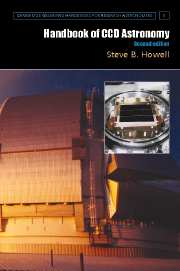Book contents
- Frontmatter
- Contents
- Preface to the first edition
- Preface to the second edition
- 1 Introduction
- 2 CCD manufacturing and operation
- 3 Characterization of charge-coupled devices
- 4 CCD imaging
- 5 Photometry and astrometry
- 6 Spectroscopy with CCDs
- 7 CCDs used in space and at short wavelengths
- Appendices
- References
- Index
6 - Spectroscopy with CCDs
Published online by Cambridge University Press: 05 June 2012
- Frontmatter
- Contents
- Preface to the first edition
- Preface to the second edition
- 1 Introduction
- 2 CCD manufacturing and operation
- 3 Characterization of charge-coupled devices
- 4 CCD imaging
- 5 Photometry and astrometry
- 6 Spectroscopy with CCDs
- 7 CCDs used in space and at short wavelengths
- Appendices
- References
- Index
Summary
Although imaging and photometry have been and continue to be mainstays of astronomical observations, spectroscopy is indeed the premier method by which we can learn the physics that occurs within or near the object under study. Photographic plates obtained the first astronomical spectra of bright stars in the late nineteenth century, while the early twentieth century saw the hand-in-hand development of astronomical spectroscopy and atomic physics. Astronomical spectroscopy with photographic plates, or with some method of image enhancement placed in front of a photographic plate, has led to numerous discoveries and formed the basis for modern astrophysics. Astronomical spectra have also had a profound influence on the development of the fields of quantum mechanics and the physics of extreme environments. The low quantum efficiency and nonlinear response of photographic plates placed the ultimate limiting factors on their use.
During the 1970s and early 1980s, astronomy saw the introduction of numerous electronic imaging devices, most of which were applied as detectors for spectroscopic observations. Television- type devices, diode arrays, and various silicon arrays such as Reticons were called into use. They were a step up from plates in a number of respects, one of which was their ability to image not only a spectrum of an object of interest, but, simultaneously, the nearby sky background spectrum as well – a feat not always possible with photographic plates.
- Type
- Chapter
- Information
- Handbook of CCD Astronomy , pp. 135 - 166Publisher: Cambridge University PressPrint publication year: 2006
- 1
- Cited by

